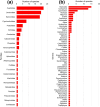Global Patterns and Drivers of Freshwater Fish Extinctions: Can We Learn From Our Losses?
- PMID: 40387501
- PMCID: PMC12087526
- DOI: 10.1111/gcb.70244
Global Patterns and Drivers of Freshwater Fish Extinctions: Can We Learn From Our Losses?
Abstract
Nearly one-third of extant freshwater fish species, which account for over 50% of global fish diversity, are at risk of extinction. Despite their crucial ecological and socioeconomic importance, the extinction of freshwater fishes remains under-researched on a global scale. This is a comprehensive assessment of taxonomic, spatial, and temporal patterns of freshwater fish extinctions while identifying key extinction drivers and driver synergies. Using data from the International Union for Conservation of Nature Red List, 89 extinct freshwater fish and 11 extinct in the wild were analyzed. Taxonomic statistical analysis revealed the disproportionate impact on Cyprinidae, Leuciscidae, and Salmonidae. Estimated globally for the period 1851-2016, the modern extinction rate for freshwater fishes stands at 33.47 extinctions per million species-years (E/MSY), more than 100 times greater than the natural background extinction rate of 0.33 E/MSY. Extinction rates, when calculated per continent using the number of extinct species and the total number of species per continent, indicated that North America has the highest extinction rate (225.60 E/MSY), followed by Europe (220.26 E/MSY) and Asia (34.62 E/MSY). Although Africa is less affected, it still shows a 42-fold increase over the background rate. Bayesian modeling, reflecting cumulative species extinctions, indicated a strong association of North America and Asia with species loss (37 and 34 extinctions, respectively), a moderate one for Europe (20 extinctions) and a weak association of Africa (eight extinctions). Natural system modification, pollution, and invasive species emerged as the primary extinction drivers, often acting synergistically. Temporal trends indicate an acceleration in extinctions since the mid-20th century. This study highlights that, despite recent increases in conservation efforts, freshwater fish extinctions continue to rise, indicating the urgent need for integrated conservation strategies. Without immediate action, many species currently at risk may soon follow the same trajectory of extinction as the 100 extinct freshwater fishes of this study.
Keywords: IUCN; biodiversity; conservation; extinction rates; freshwater fishes.
© 2025 The Author(s). Global Change Biology published by John Wiley & Sons Ltd.
Conflict of interest statement
The authors declare no conflicts of interest.
Figures







Similar articles
-
Diversity, extinction risk and conservation of Malaysian fishes.J Fish Biol. 2010 Jun;76(9):2009-66. doi: 10.1111/j.1095-8649.2010.02685.x. J Fish Biol. 2010. PMID: 20557654
-
Trait-based prediction of extinction risk of small-bodied freshwater fishes.Conserv Biol. 2017 Jun;31(3):581-591. doi: 10.1111/cobi.12882. Epub 2017 Jan 30. Conserv Biol. 2017. PMID: 27976421
-
Not knowing, not recording, not listing: numerous unnoticed mollusk extinctions.Conserv Biol. 2009 Oct;23(5):1214-21. doi: 10.1111/j.1523-1739.2009.01245.x. Epub 2009 May 18. Conserv Biol. 2009. PMID: 19459894
-
A review of conservation status of freshwater fish diversity in China.J Fish Biol. 2024 Feb;104(2):345-364. doi: 10.1111/jfb.15606. Epub 2023 Dec 19. J Fish Biol. 2024. PMID: 37927158 Review.
-
The Sixth Mass Extinction: fact, fiction or speculation?Biol Rev Camb Philos Soc. 2022 Apr;97(2):640-663. doi: 10.1111/brv.12816. Epub 2022 Jan 10. Biol Rev Camb Philos Soc. 2022. PMID: 35014169 Free PMC article. Review.
References
-
- Aloo, P. A. , Njiru J., Balirwa J. S., and Nyamweya C. S.. 2017. “Impacts of Nile Perch, Lates Niloticus, Introduction on the Ecology, Economy and Conservation of Lake Victoria, East Africa.” Lakes & Reservoirs: Research and Management 22: 320–333. 10.1111/lre.12192. - DOI
-
- Arthington, A. H. , Bhaduri A., Bunn S. E., et al. 2018. “The Brisbane Declaration and Global Action Agenda on Environmental Flows (2018).” Frontiers in Environmental Science 6: 45. 10.3389/fenvs.2018.00045. - DOI
-
- Bănăduc, D. , Simić V., Cianfaglione K., et al. 2022. “Freshwater as a Sustainable Resource and Generator of Secondary Resources in the 21st Century: Stressors, Threats, Risks, Management and Protection Strategies, and Conservation Approaches.” International Journal of Environmental Research and Public Health 19, no. 24: 16570. 10.3390/ijerph192416570. - DOI - PMC - PubMed
-
- Bellmore, J. R. , Duda J. J., Craig L. S., et al. 2017. “Status and Trends of Dam Removal Research in the United States.” Wiley Interdisciplinary Reviews: Water 4, no. 2: e1164. 10.1002/wat2.1164. - DOI
MeSH terms
LinkOut - more resources
Full Text Sources

